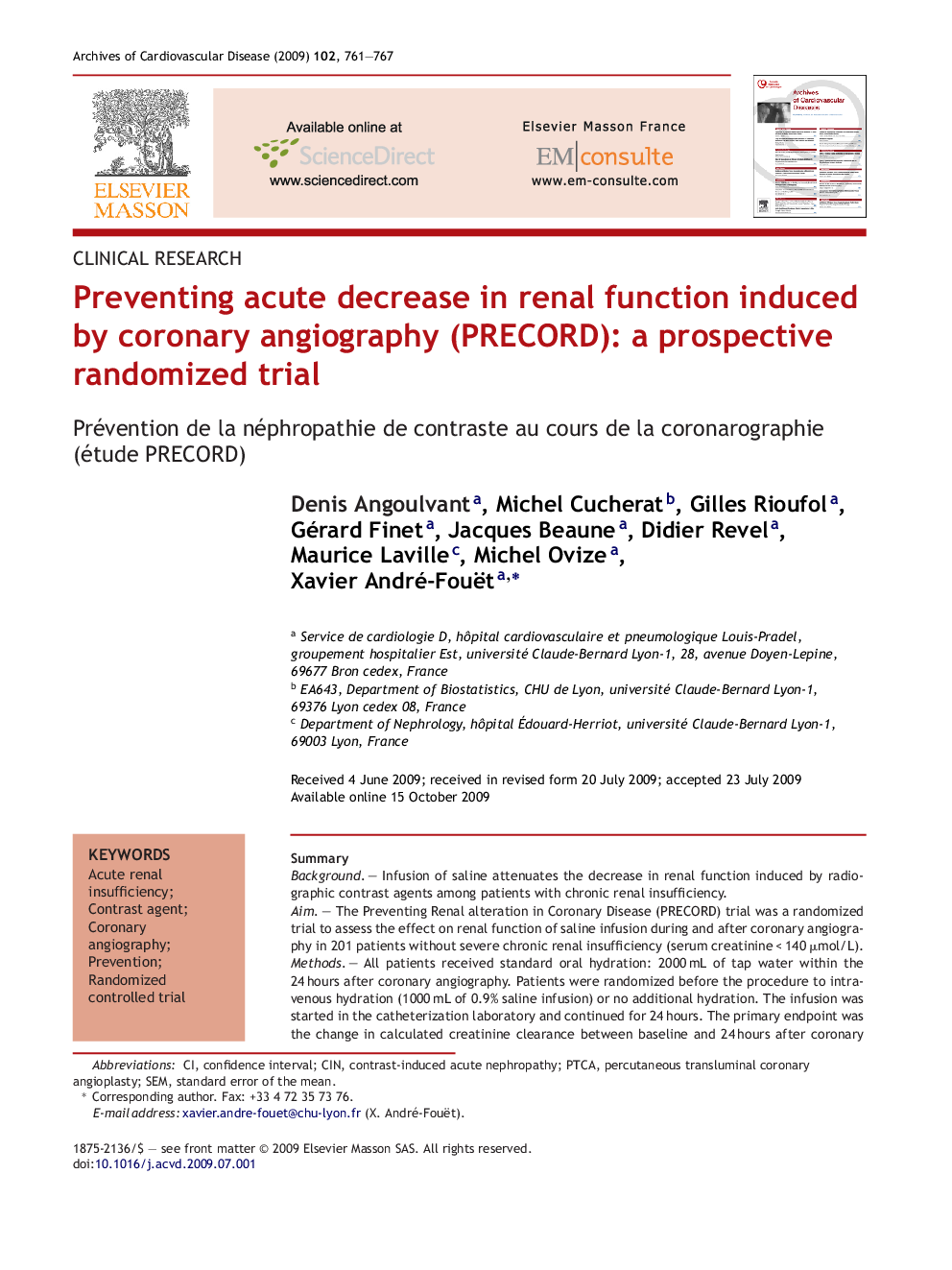| کد مقاله | کد نشریه | سال انتشار | مقاله انگلیسی | نسخه تمام متن |
|---|---|---|---|---|
| 2889906 | 1574399 | 2009 | 7 صفحه PDF | دانلود رایگان |

SummaryBackgroundInfusion of saline attenuates the decrease in renal function induced by radiographic contrast agents among patients with chronic renal insufficiency.AimThe Preventing Renal alteration in Coronary Disease (PRECORD) trial was a randomized trial to assess the effect on renal function of saline infusion during and after coronary angiography in 201 patients without severe chronic renal insufficiency (serum creatinine < 140 μmol/L).MethodsAll patients received standard oral hydration: 2000 mL of tap water within the 24 hours after coronary angiography. Patients were randomized before the procedure to intravenous hydration (1000 mL of 0.9% saline infusion) or no additional hydration. The infusion was started in the catheterization laboratory and continued for 24 hours. The primary endpoint was the change in calculated creatinine clearance between baseline and 24 hours after coronary angiography. The same ionic low osmolar radiographic contrast agent (ioxaglate) was used in all patients.ResultsBoth groups had similar baseline characteristics, including age, serum creatinine, volume of contrast and proportion of patients undergoing ad hoc coronary angioplasty. The overall decrease in serum creatinine clearance 24 hours after the procedure was –3.44 (0.68) mL/min. The change in serum creatinine clearance 24 hours after the procedure was –2.81 (1.07) mL/min in the infusion group vs –4.09 (0.91) mL/min in the control group (p = 0.38).ConclusionRenal function is altered only slightly 24 hours after coronary angiography with standard oral hydration alone and is not affected by saline infusion started at the beginning of coronary angiography, even in patients with mild-to-moderate renal dysfunction.
RésuméPrérequisLa perfusion de sérum salé prévient la dégradation de la fonction rénale après injection de produit de contraste chez les insuffisants rénaux chroniques.ObjectifL’étude Preventing Renal alteration in Coronary Disease (PRECORD) est un essai thérapeutique randomisé évaluant l’effet protecteur de la perfusion de sérum salé au cours d’une coronarographie chez 201 patients non insuffisants rénaux sévères (créatininémie < 140 μmol/L).MéthodesTous les patients recevaient une hydratation orale de 2000 mL d’eau du robinet dans les 24 heures suivant la coronarographie. Les patients étaient randomisés avant l’examen en deux groupes : un groupe recevant une hydratation supplémentaire par sérum salé 0,9 % intraveineux 1000 mL débuté en salle de cathétérisme et poursuivi pendant 24 heures, et un groupe témoin sans hydratation supplémentaire. Le critère majeur était la diminution de la clairance de la créatininémie calculée à 24 heures. Pendant la coronarographie, tous les patients recevaient le même agent de contraste ionique à osmolarité basse (ioxaglate).RésultatsLes deux groupes étaient comparables à l’inclusion en ce qui concerne l’age, la créatininémie, la quantité de produit de contraste et le nombre d’angioplastie. La diminution moyenne de la clairance de la créatininémie observée à 24 heures était de –3,44 (0,68) mL/min. Dans le groupe recevant la perfusion de sérum salé elle était de –2,81 (1,07) mL/min et dans le groupe témoin de –4,09 (0,91) mL/min (p = 0,38).ConclusionLa fonction rénale n’est que modérément altérée après une coronarographie chez les patients recevant une hydratation préventive per os. L’ajout d’une hydratation intraveineuse en début de coronarographie n’entraîne pas de bénéfice significatif chez des patients n’ayant pas d’insuffisance rénale sévère.
Journal: Archives of Cardiovascular Diseases - Volume 102, Issue 11, November 2009, Pages 761–767